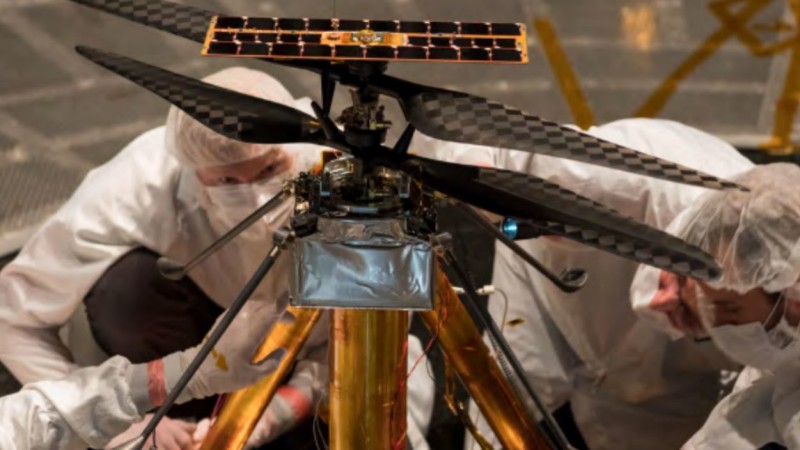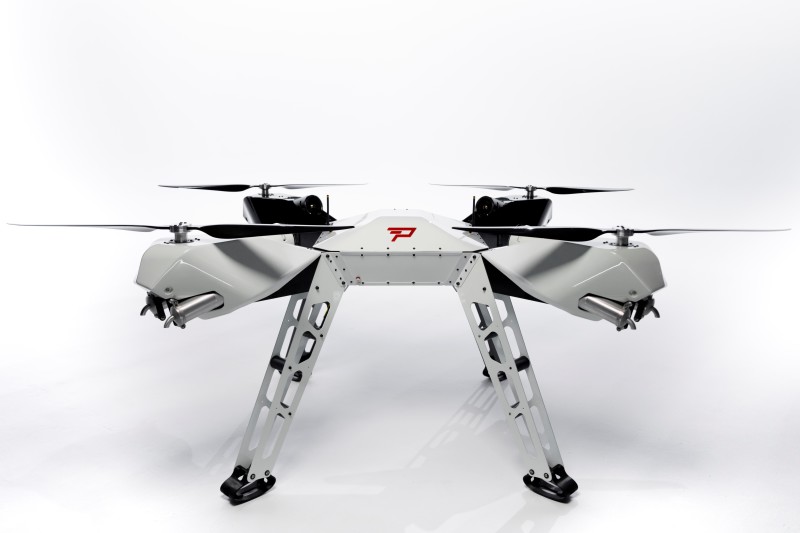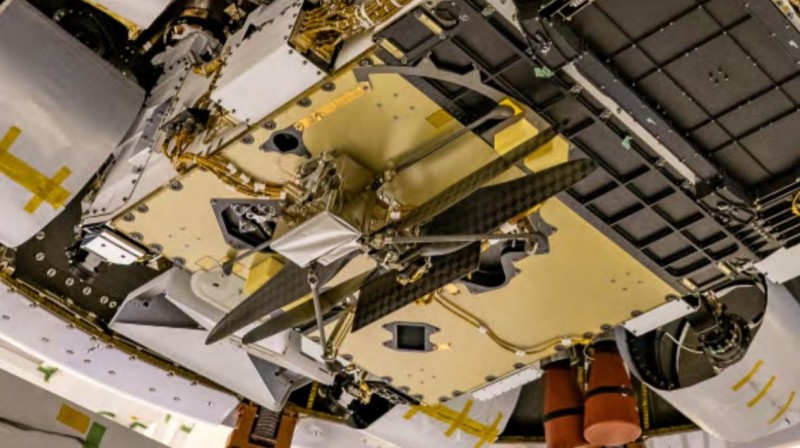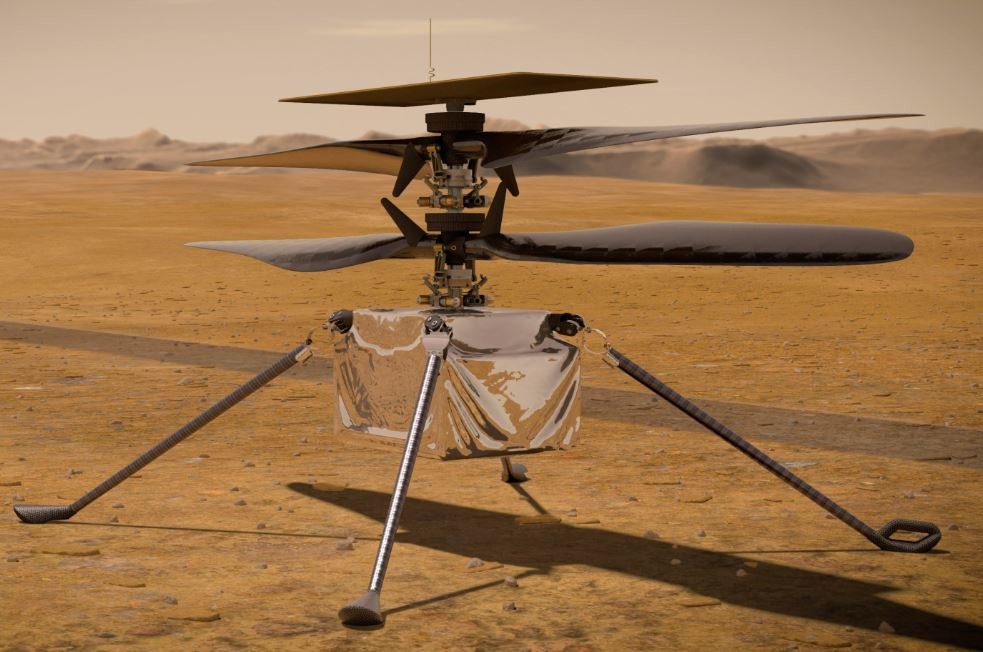On February 18th the National Aeronautics and Space Administration (NASA) landed its Perseverance rover on the surface of the red planet, and, hanging from the belly of the car-sized craft is a small unmanned aerial vehicle (UAV) known as Ingenuity. Back in 2019 at the SPAR3D event in Anaheim, MiMi Aung, Deputy Division Manager of Autonomous Systems at NASA Jet Propulsion Laboratory, gave a keynote on the challenges of designing a helicopter that would fly on Mars. Today, we are just weeks away from our first unmanned flight on another planet.
Ingenuity was developed at the NASA Jet Propulsion Laboratories (JPL) in Pasadena, California, and it’s an engineering marvel. Even though NASA does not label the unmanned craft as a drone or UAV, it fits the bill: it flies independently of human interaction, is electrically powered, and uses blades to generate lift.
The exact specs are fascinating given the fact that Mars’ atmosphere has about 1% the density of Earth’s, which means the ratio of blade surface to weight is enormous. The rover weighs 4 lbs or 1.8 Kg (which translates to 1.6 lbs on Mars) and the wingspan of the blades is 4 ft. The two blades counter rotate to eliminate torque at 2,400 revolutions per minute (RPM), creating the necessary lift to counter the weight of the vehicle and fly.
We reached out to the Ingenuity engineers at NASA JPL and also to the engineering team at Parallel Flight Technologies (PFT) to compare the specifications of the two vehicles, one designed for flying low weight over Mars and one for heavy lifting on Earth. The differences are incredible.
In helicopter design, the most important number to determine lift is known as disk loading and is expressed in terms of weight over area (Kg/m2). In the case of the Beta version of PFT’s vehicle, the disk loading is 36.4 Kg/m2 and, in the case of Ingenuity, it’s 0.62 Kg/m2 on the surface of Mars. In terms of size, Ingenuity is 19 inches tall and its two rotors are 48 inches in diameter, while PFT’s Beta is 3.28 ft in height and has four rotors of 40 inches in diameter each.

Image Courtesy of NASA JPL
Ingenuity uses 350W to hover during flight and weighs 1.6 lbs (0.73 kg) on Mars, while PFT’s Beta uses 26 kW. The hover lift efficiency of Ingenuity is 2.07 kW/kg, about half of the hover lift efficiency of the Parallel Flight Technologies beta aircraft on Earth (4.54 kW/kg), which is remarkable given the fact that Mars atmosphere is only 1% of Earth.

Image Courtesy of Parallel Flight Technology
These specifications are impressive, especially when we compare them against what we are used to seeing on Earth, but how did it get to the surface of Mars? Ingenuity is nestled up sideways under the belly of the Perseverance rover with a cover to protect it from the debris kicked up during landing. Both the rover and the helicopter were safely ensconced inside a clamshell-like entry capsule during the 293-million-mile (471-million-kilometer) journey to Mars. The power system on the Mars 2020 spacecraft periodically charges Ingenuity’s batteries on the way there.

Image Courtesy of NASA JPL
The purpose of Ingenuity is not scientific, but to test engineering. Ingenuity is intended to demonstrate technologies needed for flying in the Martian atmosphere. If successful, these technologies could enable other advanced robotic flying vehicles that might be part of future robotic and human missions to Mars. Possible uses of a future helicopter on Mars include offering a unique viewpoint not provided by current orbiters high overhead or by rovers and landers on the ground; high-definition images and reconnaissance for robots or humans; and access to terrain that is difficult for rovers to reach. A future helicopter could even help carry light but vital payloads from one site to another.
Part of what makes Ingenuity a UAV is precisely its independence or autonomy. Delays are an inherent part of communicating with spacecraft across interplanetary distances, which means the helicopter’s flight controllers at JPL won’t be able to control it with a joystick or to look at engineering data or images from each flight until well after the flight took place. Therefore, Ingenuity will make some of its own decisions based on parameters set by its engineers on Earth. Ingenuity has a kind of programmable thermostat, for instance, that will keep it warm on Mars. During flight, Ingenuity will analyze sensor data and images of the terrain to ensure it stays on the flight path programmed by project engineers.
Talk about flying beyond visual line of sight (BVLOS)!
The flight per se will not occur immediately after Perseverance’s arrival on Mars. Once a suitable site to deploy the helicopter is found, the rover’s Mars Helicopter Delivery System will shed the landing cover, rotate the helicopter to a legs-down configuration, and gently drop Ingenuity on the surface in the first few months after landing.
Throughout the helicopter’s flight test campaign, the rover will assist in communications back and forth from Earth and also plans to collect some images of Ingenuity flying over the surface of Mars.
The three key objectives of Ingenuity as defined by NASA are:
- Prove powered flight in the thin atmosphere and lower gravity of Mars (about one third that of Earth).
- Demonstrate miniaturized flying technology, which requires shrinking down onboard computers, electronics and other parts so that the aircraft is light enough to take off.
- Operate autonomously. Ingenuity will use solar power to charge its batteries and rely on internal heaters to maintain operational temperatures during the cold Martian nights. After receiving commands from Earth relayed through the rover, each test flight is performed without real-time input from Mars Helicopter mission controllers.
It's very rare for NASA to have a mission which is not scientific in nature but in this case, they are launching a vehicle with the sole purpose of proving a point and answering an engineering question: Is it possible to fly in Mars?
Now that Perseverance and Ingenuity are safely on Mars, the question is now when is it going to fly? JPL is planning for Perseverance to deploy Ingenuity to the surface of the planet between 60 and 90 Martian days after the arrival on the red planet. In other words, Ingenuity should be in place and ready to take its first flight between April 19 and May 19, 2021.
With regards to the future of manned flights on Mars, if NASA proves that it is feasible with Ingenuity, then the temptation would be to design an aerial vehicle to assist astronauts. But given the enormous wingspan necessary to lift 1.6 lbs on the surface of the red planet, we can only imagine the colossal dimensions of a vehicle destined to lift humans. Perhaps this is why we haven’t yet heard NASA speak of this in its official communications. Future flying machines in such a thin atmosphere will likely be restricted to small payloads and difficult-to-reach areas for scientific sensors.
For now, we are happy that Perseverance landed safely on Mars and that in a few weeks, we will be watching the first flight of a human-made UAV on another planet. There are exciting times ahead.















Comments